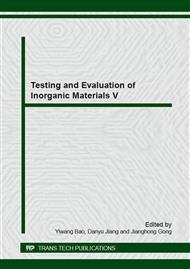p.7
p.11
p.17
p.21
p.26
p.31
p.35
p.39
p.45
Preparation and Characterization of Wire-Liked NiFe2O4 Nanoparticles with High Specific Area and Excellent Magnetic Properties via a Template-Assembled Sol-Gel Method
Abstract:
A simple template assembled sol-gel method is used to prepare the wire-liked NiFe2O4 nano-particles with high specific surface area and excellent magnetic. Influence of template and calcined temperatures on the composition, microstructure, BET, magnetic properties as well as radio frequency(RF) heating rate are studied through XRD, TEM, BET, VSM and RF heat test. Results show that the template-assembled sol-gel method is a successful and easy method to obtain randomly oriented wire-liked NiFe2O4 nano-particles. The spinel NiFe2O4 was the main phase, impurity rhombohedral Fe2O3 phase is also detected in all samples. An increase in grain size is observed with the increased calcined temperatures as well as the concentration of sol, while the specific surface area decreases from 50.3 to 13.2 m2/g. As the sintering temperature equals to 700°C, the nano-particles can be observed with a diameter approximately 50 nm and a length approximately 700 nm. Ms increases with the increase of sintering temperature and slightly waves with the increase of sol concentrations, C-1-1000 exhibits higher Ms (73.0 emu/g) and lower Mr and Hc values (13.5 emu/g, 79.3Oe ), respectively. The calculated hysteresis loss and the measured RF heating rate exhibits good agreement. The sample C-1-800 has the highest heating rate of 1.72 °C/s.
Info:
Periodical:
Pages:
26-30
Citation:
Online since:
November 2014
Authors:
Price:
Сopyright:
© 2015 Trans Tech Publications Ltd. All Rights Reserved
Share:
Citation:


